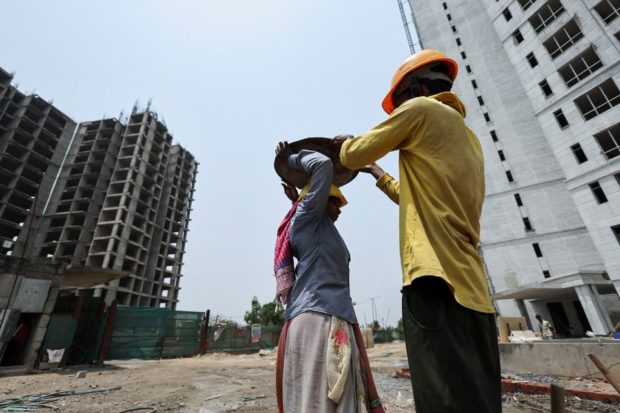
Labourers work at a construction site on a hot summer day in Noida, India, May 12, 2022. REUTERS
NOIDA, India — For construction worker Yogendra Tundre, life at a building site on the outskirts of the Indian capital New Delhi is hard enough. This year, record high temperatures are making it unbearable.
As India grapples with an unprecedented heatwave, the country’s vast majority of poor workers, who generally work outdoors, are vulnerable to the scorching temperatures.
“There is too much heat and if we won’t work, what will we eat? For a few days, we work and then we sit idle for a few days because of tiredness and heat,” Tundre said.
Temperatures in the New Delhi area have touched 45 degrees Celsius (113 Fahrenheit) this year, often causing Tundre, and his wife Lata, who works at the same construction site, to fall sick. That in turn means they lose income.
“Because of heat, sometimes I don’t go to work. I take days off… many times, fall sick from dehydration and then require glucose bottles (intravenous fluids),” Lata said while standing outside their house, a temporary shanty with a tin roof.
Scientists have linked the early onset of an intense summer to climate change, and say more than a billion people in India and neighboring Pakistan were in some way at risk from the extreme heat.
India suffered its hottest March in more than 100 years and parts of the country experienced their highest temperatures on record in April.
Many places, including New Delhi, saw the temperature gauge top 40 degrees Celsius. More than two dozen people have died of suspected heat strokes since late March, and power demand has hit multi-year highs.
Prime Minister Narendra Modi has called on state governments to draw up measures to mitigate the impact of the extreme heat.
Tundre and Lata live with their two young children in a slum near the construction site in Noida, a satellite city of New Delhi. They moved from their home state of Chhattisgarh in central India to seek work and higher wages around the capital.
On the construction site, labourers scale up walls, lay concrete and carry heavy loads, using ragged scarves around their heads as protection against the sun.
But even when the couple finish their day’s work, they have little respite as their home is hot, having absorbed the heat of the sun all day long.
Avikal Somvanshi, an urban environment researcher from India’s Center for Science and Environment, said federal government data showed that heat stress was the most-common cause of death, after lightning, from forces of nature in the last twenty years.
“Most of these deaths occur in men aged 30-45. These are working class, blue-collar men who have no option but to be working in the scorching heat,” Somvanshi said.
There are no laws in India that prevent outdoor activity when temperatures breach a certain level, unlike in some Middle-Eastern countries, Somvanshi said.
RELATED STORIES
India bans wheat exports as heat wave hurts crop, domestic prices soar
Temperatures break monthly records in India under heat wave
As India swelters under extreme heat, Modi warns of fire risk
Global warming: even cacti can’t take the heat